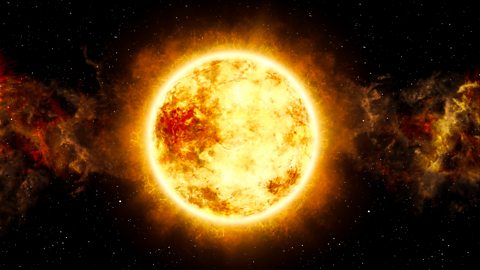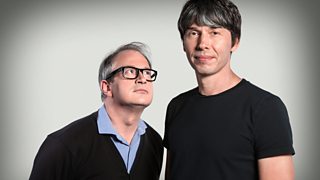So-lar so good – how the sun made us who we are

It’s that big ball of gas that occasionally appears in the sky above us and is the main driver behind the entire sunblock industry. Yes, it’s the Sun which was the subject of a grilling by the Infinite Monkey Cage team.
Brian Cox and Robin Ince were joined by solar scientist Dr Lucie Green, Sun-and-snail expert Prof Steve Jones, and comedian Tim Minchin to shed some light on this over-heated marvel.
It could be why we left the ocean

Some great scientific minds believe that life on Earth started on the ocean floor, possibly alongside heated, gas gushing vents. But as Steve Jones points out: “Life is an improbable chemical reaction that needs energy.” So it could be that these simple biological forms on the seabed moved towards the surface so they could be closer to the energy provided by the Sun. And then, also possibly, these life forms got out of the ocean and started evolving into other things like birds and wasps and postmen.
The Sun made us everything we are.Prof. Steve Jones
It might be why we walk upright
And once we were out of the ocean, we eventually decided to get up off all fours and start strutting around on two legs. And this too could be all down to the Sun. One theory states that when primates came down from living in the trees, but were still on all fours, they discovered a lot more of their skin was exposed to the Sun. So, the theory continues, slowly they evolved to stand upright so less skin was showing and began to walk, which further resulted in us becoming hunters and gatherers and helped to make us the dominant species on the planet. “So,” as Steve Jones says, “the Sun made us everything we are.”
Without it our eyes would be very weird
As Lucie Green reveals: “The sun is an amazing emitter.” It’s not just visible sunlight that streams from its surface but all sorts of different types of light. Long wavelength radio waves, infrared waves, ultraviolet waves, x-rays and many more bombard our planet. The planet’s atmosphere protects us from the most dangerous of these waves and visible sunlight makes it through. If it was longer radio waves, rather than sunlight, that penetrated, your eyes would need to be roughly 3000 metres across to see with the same resolution as we do now.

It's a middle-aged star, about 4.5 billion years old...
Solar scientist Lucie Green's one-minute need-to-know guide to the Sun.
It could power the world forever
Studying the Sun is tricky as we can’t just stare at it all day long, as our eyes don’t really appreciate this, due to its immense power. Though, compared to other stars, our sun is fairly placid and stable; it doesn’t like to cause a fuss in astronomical terms – it’s still incredibly powerful. As Steve Jones points out: “If you were to take a 300km square in the Sahara and cover it completely in solar panels, the solar energy that would land on those solar panels would power the entire world forever at no cost.”

In Australia, the Sun’s not withheld from us.Tim Minchin
It’s middle-aged
It’s thought that the Sun is such an efficient provider of power and light for our planet because it manages to be stable and fairly predictable. And this is all down to its age. It’s currently 4.5 billion years old – about halfway through its life. In its younger days it would have been more volatile and dramatic, but now it’s satisfied to have the occasional potter around the garden centre and finds excitement in a Pointless marathon on UKTV Challenge. In solar terms.
Sunlight is as old as us
Even though it only takes eight minutes for sunlight to travel from the surface of the sun to the surface on the Earth, the journey from the core of the sun to its surface takes 200,000 years. So the sunlight you are experiencing right now is very old indeed. In fact, as Lucie Green says: “It’s as old as modern humans are.”
It helps to form us
Tim Minchin believes that exposure (or not) to the Sun directly affects culture and the way we create. He feels the lack of sun in the UK, for large parts of the year, fuels our creative drive and influences the media we make. But this is accompanied by, according to Tim, “a society-wide depression that sits on you for a month or two. But then the Spring comes and you have this joy that I haven’t seen in Australia, because the Sun’s not withheld from us.”
It cheers us up
Seeing the Sun shine and feeling that warmth on our faces doesn’t just put us in a good mood psychologically. It actually causes a physical change in our bodies that alters our mood. As Steve Jones explains: “We now know what the Sun does – it actually generates mood hormones in your skin. Serotonin is one of them. And it changes your mood physically through these hormones – so the Sun literally, as well as metaphorically, makes your day.”
-
![]()
The Infinite Monkey Cage: The Sun
To stream and download: Brian Cox and Robin Ince are joined by Tim Minchin, solar scientist Lucie Green and biologist Steve Jones to look at the dazzling impact the Sun has on life on Earth.

Out-of-this-world programmes on Radio 4
-
![]()
Watch: The Infinite Monkey Cage UFO Special
Brian Cox, Robin Ince and special guests ask if UFOs and aliens have visited Earth.
-
![]()
In Our Time: Dark Matter
Melvyn Bragg and his guests discuss dark matter, the "missing mass" of the universe.
-
![]()
Science Stories: Chaucer's Astrolabe – The Medieval GPS
Chaucer's Astrolabe and how a renowned poet wrote the world's first scientific manual.
-
![]()
The Infinite Monkey Cage: Black Holes
Brian Cox and Robin Ince push actor and comedian Matt Lucas into a black hole, all in the name of science.





















